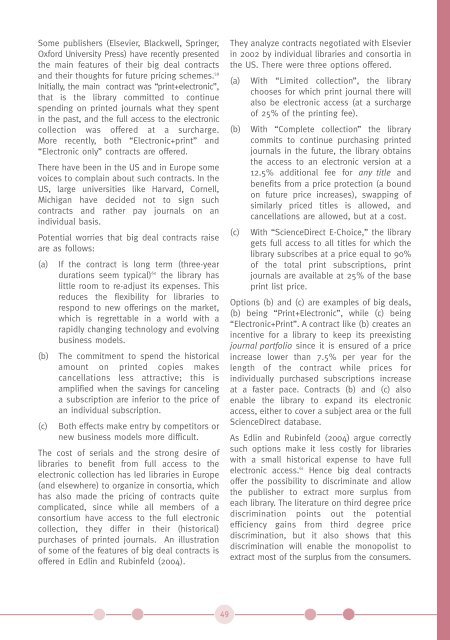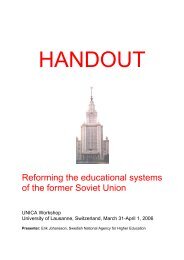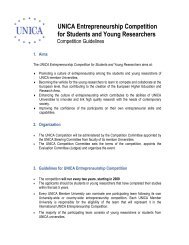Study on the economic and technical evolution of the scientific ...
Study on the economic and technical evolution of the scientific ...
Study on the economic and technical evolution of the scientific ...
You also want an ePaper? Increase the reach of your titles
YUMPU automatically turns print PDFs into web optimized ePapers that Google loves.
Some publishers (Elsevier, Blackwell, Springer,<br />
Oxford University Press) have recently presented<br />
<strong>the</strong> main features <strong>of</strong> <strong>the</strong>ir big deal c<strong>on</strong>tracts<br />
<strong>and</strong> <strong>the</strong>ir thoughts for future pricing schemes. 59<br />
Initially, <strong>the</strong> main c<strong>on</strong>tract was “print+electr<strong>on</strong>ic”,<br />
that is <strong>the</strong> library committed to c<strong>on</strong>tinue<br />
spending <strong>on</strong> printed journals what <strong>the</strong>y spent<br />
in <strong>the</strong> past, <strong>and</strong> <strong>the</strong> full access to <strong>the</strong> electr<strong>on</strong>ic<br />
collecti<strong>on</strong> was <strong>of</strong>fered at a surcharge.<br />
More recently, both “Electr<strong>on</strong>ic+print” <strong>and</strong><br />
“Electr<strong>on</strong>ic <strong>on</strong>ly” c<strong>on</strong>tracts are <strong>of</strong>fered.<br />
There have been in <strong>the</strong> US <strong>and</strong> in Europe some<br />
voices to complain about such c<strong>on</strong>tracts. In <strong>the</strong><br />
US, large universities like Harvard, Cornell,<br />
Michigan have decided not to sign such<br />
c<strong>on</strong>tracts <strong>and</strong> ra<strong>the</strong>r pay journals <strong>on</strong> an<br />
individual basis.<br />
Potential worries that big deal c<strong>on</strong>tracts raise<br />
are as follows:<br />
(a) If <strong>the</strong> c<strong>on</strong>tract is l<strong>on</strong>g term (three-year<br />
durati<strong>on</strong>s seem typical) 60 <strong>the</strong> library has<br />
little room to re-adjust its expenses. This<br />
reduces <strong>the</strong> flexibility for libraries to<br />
resp<strong>on</strong>d to new <strong>of</strong>ferings <strong>on</strong> <strong>the</strong> market,<br />
which is regrettable in a world with a<br />
rapidly changing technology <strong>and</strong> evolving<br />
business models.<br />
(b) The commitment to spend <strong>the</strong> historical<br />
amount <strong>on</strong> printed copies makes<br />
cancellati<strong>on</strong>s less attractive; this is<br />
amplified when <strong>the</strong> savings for canceling<br />
a subscripti<strong>on</strong> are inferior to <strong>the</strong> price <strong>of</strong><br />
an individual subscripti<strong>on</strong>.<br />
(c) Both effects make entry by competitors or<br />
new business models more difficult.<br />
The cost <strong>of</strong> serials <strong>and</strong> <strong>the</strong> str<strong>on</strong>g desire <strong>of</strong><br />
libraries to benefit from full access to <strong>the</strong><br />
electr<strong>on</strong>ic collecti<strong>on</strong> has led libraries in Europe<br />
(<strong>and</strong> elsewhere) to organize in c<strong>on</strong>sortia, which<br />
has also made <strong>the</strong> pricing <strong>of</strong> c<strong>on</strong>tracts quite<br />
complicated, since while all members <strong>of</strong> a<br />
c<strong>on</strong>sortium have access to <strong>the</strong> full electr<strong>on</strong>ic<br />
collecti<strong>on</strong>, <strong>the</strong>y differ in <strong>the</strong>ir (historical)<br />
purchases <strong>of</strong> printed journals. An illustrati<strong>on</strong><br />
<strong>of</strong> some <strong>of</strong> <strong>the</strong> features <strong>of</strong> big deal c<strong>on</strong>tracts is<br />
<strong>of</strong>fered in Edlin <strong>and</strong> Rubinfeld (2004).<br />
They analyze c<strong>on</strong>tracts negotiated with Elsevier<br />
in 2002 by individual libraries <strong>and</strong> c<strong>on</strong>sortia in<br />
<strong>the</strong> US. There were three opti<strong>on</strong>s <strong>of</strong>fered.<br />
(a) With “Limited collecti<strong>on</strong>”, <strong>the</strong> library<br />
chooses for which print journal <strong>the</strong>re will<br />
also be electr<strong>on</strong>ic access (at a surcharge<br />
<strong>of</strong> 25% <strong>of</strong> <strong>the</strong> printing fee).<br />
(b) With “Complete collecti<strong>on</strong>” <strong>the</strong> library<br />
commits to c<strong>on</strong>tinue purchasing printed<br />
journals in <strong>the</strong> future, <strong>the</strong> library obtains<br />
<strong>the</strong> access to an electr<strong>on</strong>ic versi<strong>on</strong> at a<br />
12.5% additi<strong>on</strong>al fee for any title <strong>and</strong><br />
benefits from a price protecti<strong>on</strong> (a bound<br />
<strong>on</strong> future price increases), swapping <strong>of</strong><br />
similarly priced titles is allowed, <strong>and</strong><br />
cancellati<strong>on</strong>s are allowed, but at a cost.<br />
(c) With “ScienceDirect E-Choice,” <strong>the</strong> library<br />
gets full access to all titles for which <strong>the</strong><br />
library subscribes at a price equal to 90%<br />
<strong>of</strong> <strong>the</strong> total print subscripti<strong>on</strong>s, print<br />
journals are available at 25% <strong>of</strong> <strong>the</strong> base<br />
print list price.<br />
Opti<strong>on</strong>s (b) <strong>and</strong> (c) are examples <strong>of</strong> big deals,<br />
(b) being “Print+Electr<strong>on</strong>ic”, while (c) being<br />
“Electr<strong>on</strong>ic+Print”. A c<strong>on</strong>tract like (b) creates an<br />
incentive for a library to keep its preexisting<br />
journal portfolio since it is ensured <strong>of</strong> a price<br />
increase lower than 7.5% per year for <strong>the</strong><br />
length <strong>of</strong> <strong>the</strong> c<strong>on</strong>tract while prices for<br />
individually purchased subscripti<strong>on</strong>s increase<br />
at a faster pace. C<strong>on</strong>tracts (b) <strong>and</strong> (c) also<br />
enable <strong>the</strong> library to exp<strong>and</strong> its electr<strong>on</strong>ic<br />
access, ei<strong>the</strong>r to cover a subject area or <strong>the</strong> full<br />
ScienceDirect database.<br />
As Edlin <strong>and</strong> Rubinfeld (2004) argue correctly<br />
such opti<strong>on</strong>s make it less costly for libraries<br />
with a small historical expense to have full<br />
electr<strong>on</strong>ic access. 61 Hence big deal c<strong>on</strong>tracts<br />
<strong>of</strong>fer <strong>the</strong> possibility to discriminate <strong>and</strong> allow<br />
<strong>the</strong> publisher to extract more surplus from<br />
each library. The literature <strong>on</strong> third degree price<br />
discriminati<strong>on</strong> points out <strong>the</strong> potential<br />
efficiency gains from third degree price<br />
discriminati<strong>on</strong>, but it also shows that this<br />
discriminati<strong>on</strong> will enable <strong>the</strong> m<strong>on</strong>opolist to<br />
extract most <strong>of</strong> <strong>the</strong> surplus from <strong>the</strong> c<strong>on</strong>sumers.<br />
49
















